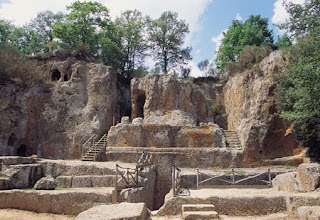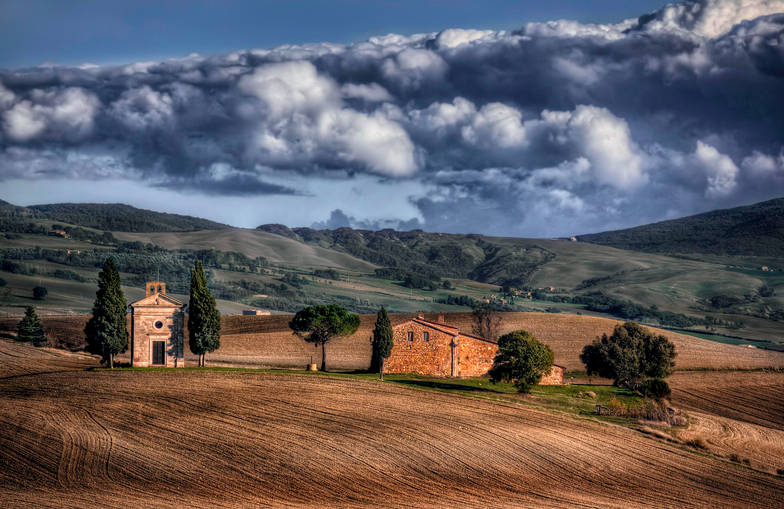Sovana
Sovana. The Etruscan and the Roman. The splendor of a city as tiny as peculiar.
The picture you see belongs to the remains of the “Tomb ILdebranda”, the biggest Etruscan mausoleum ever found. The impressive funerary monument was decorated with 12 columns at the time and the access to  it was through two stone staircases, and an underground one, which led to the large funerary chamber. The “Tomb ILdebranda” is found in the fabulous Etruscan necropolis, in the Tuscan territory of Maremma, near the border with Lacio. The “Tomb ILdebranda” as well as the whole necropolis is excavated in volcanic tuff rock. The access was and still is through “vie cave”, paths with high walls the Etruscan opened in the rock to move from one area to the other or to use as trenches at times of war.
it was through two stone staircases, and an underground one, which led to the large funerary chamber. The “Tomb ILdebranda” is found in the fabulous Etruscan necropolis, in the Tuscan territory of Maremma, near the border with Lacio. The “Tomb ILdebranda” as well as the whole necropolis is excavated in volcanic tuff rock. The access was and still is through “vie cave”, paths with high walls the Etruscan opened in the rock to move from one area to the other or to use as trenches at times of war.
“Tomb ILdebranda” dates back to the III y II centuries B.C and it was discovered in 1924 by the Rosi brothers. Not knowing to whom the impressive temple had been originally devoted, it received the name of the most illustrious son of the city of Sovana: Ildebrano de Soana, born around 1020 and elected pope in 1073 under the name of Gregory VII, who is known as one of the most cultured and spirited popes of the middle ages, protagonist of the most important reforms in the Church at those times. His unprecedented reform is essentially contained in the 27 axioms, which make up his “Dictatus Papae” of 1075, where he clearly defines the powers of the Emperor (Sacred Roman Empire) and those of the Pope, in which the former cannot interfere. Thus, he faces Emperor Henry IV, who he excommunicates twice. In 1080 the Emperor, supported by the German clergy highest ranks and Lombardo appoints Clement III pope and make the antipope excommunicate the legitimate pope. Gregory VII dies exiled in Salerno in 1085. He is canonized in 1606. One way or the other, we have introduced ourselves into the peculiar city of Sovana, a beautiful city loaded with history. Nowadays Sovana is a tiny city with a main street with houses and beautiful mansions and a marvelous main square. However, its interest only resides in its splendid and homogeneous medieval architecture, perfectly preserved, which visitors revere with the enthusiasm of those marveled before a sanctuary attached to a glorious past. 
Suana, as it was called, was one of the most relevant Etruscan centers of that civilization, whose epicenter was the territory of Maremma. The Etruscan unified different settlements by the river Flora, at the top of a volcanic tuff hill between the tributaries of Calesine and Folonia, and there they founded Suana.
The city immediately became the most important one in the area, where a huge number of farmers and hunters settled. Thanks to emblematic roads carved into the rock these dwellers could communicate and trade with other major centers such as Satonia, Saturnia, Chiusi and Cetonia.
To confront the unstoppable expansionist policy of Rome, Suana was allied to the not less powerful Vulci until III century BC, time when Cayo Tiberto adjoins the territory to the Empire. The Romans give Sovana the rank of “municipium” and continue boosting the growth of the city to the point that Suana becomes one of the richest cities in the territorial area, experimenting a significant commercial expansion due to the development of the agricultural and farming activities and the growth of a prosperous craftwork industry, which is still nowadays one of its most relevant commercial characteristics. However, Suana was reluctant to abandoning its original Etruscan culture to such an extent that even inscriptions from the I century BC were still written in the original language.
The first glimpses of Christianity only reached the city in the IV century AC. Saint Maximiliano, the patron of Sovana, was one of the protagonists of the evangelization. The new faith must have had a deep impact on the people and the saint must have been really influential and exceptional as at the turn of the century, in the V century AC Soana was elected as the Episcopal venue.
How many prodigies happened in Old Times!
Sylvia


Comments
Post a Comment